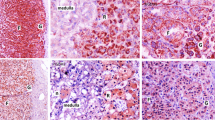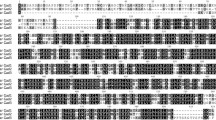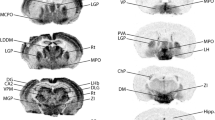Abstract
Human hGDH2 arose via duplication in the apes and driven by positive selection acquired enhanced catalytic ability under conditions inhibitory to its precursor hGDH1 (common to all mammals). To explore the biological advantage provided by the novel enzyme, we studied, by immunohistochemistry (IHC) and immunofluorescence (IF), hGDH1 and hGDH2 expression in the human brain. Studies on human cortical tissue using anti-hGDH1-specific antibody revealed that hGDH1 was expressed in glial cells (astrocytes, oligodendrocytes, and oligodendrocyte precursors) with neurons being devoid of hGDH1 staining. In contrast, an hGDH2-specific antiserum labeled both astrocytes and neurons. Specifically, hGDH2 immunoreactivity was found in the cytoplasm of large neuronal cells within coarse structures resembling mitochondria. These were distributed either in the perikaryon or in the cell periphery. Double immunofluorescence (IF) suggested that the latter represented hGDH2-labeled mitochondria of presynaptic nerve terminals. Hence, hGDH2 evolution bestowed large human neurons with enhanced glutamate metabolizing capacity, thus strengthening cortical excitatory transmission.







Similar content being viewed by others
References
Conrad B, Antonarakis SE (2007) Gene duplication: a drive for phenotypic diversity and cause of human disease. Annu Rev Genomics Hum Genet 8:17–35
Fonnum F (1984) Glutamate: a neurotransmitter in mammalian brain. J Neurochem 42:1–11
Bliss TV, Collingsridge GL (1993) A synaptic model of memory: long-term potentiation in the hippocampus. Nature 361:31–39
Schunzel G, Wolf G (1982) Topographic and quantitative characteristics of glutamate dehydrogenase of the hippocampus formation during the postnatal development of the rat brain. Comparative studies on succinate and alpha-glycerophosphate dehydrogenase with special reference to putatively glutamatergic structures. Acta Histochem 71:145–151
Rothe F, Wolf G, Schunzel G (1990) Immunohistochemical demonstration of glutamate dehydrogenase in the postnatally developing rat hippocampal formation and cerebellar cortex: comparison to activity staining. Neuroscience 39:419–429
Shashidharan P et al (1994) Novel human glutamate dehydrogenase expressed in neural and testicular tissues and encoded by an X-linked intronless gene. J Biol Chem 269:16971–16976
Burki F, Kaessmann H (2004) Birth and adaptive evolution of a hominoid gene that supports high neurotransmitter flux. Nat Gen 36:1061–1063
Plaitakis A, Latsoudis H, Spanaki C (2011) The human GLUD2 glutamate dehydrogenase and its regulation in health and disease. Neurochem Int 59:495–509
Varki A (2004) How to make an ape brain. Nat Genet 36:1034–1036
McKenna MC, Sonennewald U, Huang X, Stevenson J, Zielke HR (1996) Glutamate concentration regulates the metabolic fate of glutamate in astrocytes. J Neurochem 66:386–393
Zaganas I, Plaitakis A (2002) Single amino acid substitution (G456A) in the vicinity of the GTP binding domain of human housekeeping glutamate dehydrogenase markedly attenuates GTP inhibition and abolishes the cooperative behavior of the enzyme. J Biol Chem 277:26422–26428
Kanavouras K, Mastorodemos V, Borompokas N, Spanaki C, Plaitakis A (2007) Properties and molecular evolution of human GLUD2 (neural and testicular tissue-specific) glutamate dehydrogenase. J Neurosci Res 85:1101–1109
Rosso L, Marques AC, Reichert AS, Kaessmann H (2008) Mitochondrial targeting adaptation of the hominoid-specific glutamate dehydrogenase driven by positive Darwinian selection. PLoS Genet 4:e1000150
Aoki C, Milner TA, Berger SB, Sheu KF, Blass JP, Pickel VM (1987) Glial glutamate dehydrogenase: ultrastructural localization and regional distribution in relation to the mitochondrial enzyme, cytochrome oxidase. J Neurosci Res 18:305–318
McKenna MC, Stevenson JH, Huang X, Hopkins IB (2000) Differential distribution of the enzymes glutamate dehydrogenase and aspartate aminotransferase in cortical synaptic mitochondria contributes to metabolic compartmentation in cortical synaptic terminals. Neurochem Int 37:229–241
Spanaki C, Zaganas I, Kleopa KA, Plaitakis A (2010) Human GLUD2 glutamate dehydrogenase is expressed in neural and testicular supporting cells. J Biol Chem 285:16748–16756
Spanaki C, Plaitakis A (2012) The role of glutamate dehydrogenase in mammalian ammonia metabolism. Neurotox Res 21:117–127
Zaganas I, Spanaki C, Plaitakis A (2012) Expression of human GLUD2 glutamate dehydrogenase in human tissues: functional implications. Neurochem Int 61:455–462
Spanaki C, Kotzamani D, Petraki Z, Drakos E, Plaitakis A (2015) Expression of human GLUD1 and GLUD2 glutamate dehydrogenases in steroid producing tissues. Mol Cell Endocrinol. doi:10.1016/j.mce.2015.07.020
Spanaki C, Kotzamani D, Petraki Z, Drakos E, Plaitakis A (2014) Heterogeneous cellular distribution of glutamate dehydrogenase in brain and in non-neural tissues. Neurochem Res 39:500–515
Kleopa KA, Orthmann JL, Enriquez A, Paul DL, Scherer SS (2004) Unique distributions of the gap junction proteins connexin29, connexin32, and connexin47 in oligodendrocytes. Glia 47:346–357
di Prisco G, Banay-Schwartz M, Strecker HJ (1968) Glutamate dehydrogenase in nuclear and mitochondrial fractions of rat liver. Biochem Biophys Res Commun 33:606–612
Carey BW, Finley LW, Cross JR, Allis CD, Thompson CB (2015) Intracellular α-ketoglutarate maintains the pluripotency of embryonic stem cells. Nature 518:413–416
Koch-Nolte F, Fischer S, Haag F, Ziegler M (2011) Compartmentation of NAD+-dependent signalling. FEBS Lett 585:1651–1656
Sutendra G, Kinnaird A, Dromparis P, Paulin R, Stenson TH, Haromy A, Hashimoto K, Zhang N et al (2014) A nuclear pyruvate dehydrogenase complex is important for the generation of acetyl-CoA and histone acetylation. Cell 158:84–97
Purohit JS, Tomar RS, Panigrahi AK, Pandey SM, Singh D, Chaturvedi MM (2013) Chicken liver glutamate dehydrogenase (GDH) demonstrates a histone H3 specific protease (H3ase) activity in vitro. Biochimie 95:1999–2009
Mandal P, Chauhan S, Tomar RS (2014) H3 clipping activity of glutamate dehydrogenase is regulated by stefin B and chromatin structure. FEBS J 281:5292–5308
Schousboe A, Scafidi S, Bak LK, Waagepetersen HS, McKenna MC (2014) Glutamate metabolism in the brain focusing on astrocytes. Adv Neurobiol 11:13–30
McKenna MC, Tildon JT, Stevenson JH, Boatright R, Huang S (1993) Regulation of energy metabolism in synaptic terminals and cultured rat brain astrocytes: differences revealed using aminooxyacetate. Dev Neurosci 15:320–329
Azarias G et al (2011) Glutamate transport decreases mitochondrial pH and modulates oxidative metabolism in astrocytes. J Neurosci 31:3550–3559
Olstad E, Olsen GM, Qu H, Sonnewald U (2007) Pyruvate recycling in cultured neurons from cerebellum. J Neurosci Res 85:3318–3325
Bao X et al (2009) Transgenic expression of Glud1 (glutamate dehydrogenase 1) in neurons: in vivo model of enhanced glutamate release, altered synaptic plasticity, and selective neuronal vulnerability. J Neurosci 29:13929–13944
Verstreken P et al (2005) Synaptic mitochondria are critical for mobilization of reserve pool vesicles at Drosophila neuromuscular junctions. Neuron 47:365–378
Cavallaro S et al (1997) Late memory-related genes in the hippocampus revealed by RNA fingerprinting. Proc Natl Acad Sci U S A 94:9669–9673
Schaller B, Mekle R, Xin L, Kunz N, Gruetter R (2013) Net increase of lactate and glutamate concentration in activated human visual cortex detected with magnetic resonance spectroscopy at 7 tesla. J Neurosci Res 91:1076–1083
Shepherd GM, Harris KM (1998) Three-dimensional structure and composition of CA3→CA1 axons in rat hippocampal slices: implications for presynaptic connectivity and compartmentalization. J Neurosci 18:8300–8310
Hara Y et al (2014) Presynaptic mitochondrial morphology in monkey prefrontal cortex correlates with working memory and is improved with estrogen treatment. Proc Natl Acad Sci U S A 111:486–491
Acknowledgments
This work was supported by the European Union (European Social Fund—ESF) and Greek national funds through the operational program “Education and Lifelong Learning” of the National Strategic Reference Framework (NSRF)—Research Funding Program: THALIS—UOA, title of grant “Mechanisms of pathogenesis of Parkinson’s disease”, grant code 70/3/11679.
Author information
Authors and Affiliations
Corresponding author
Rights and permissions
About this article
Cite this article
Spanaki, C., Kotzamani, D., Kleopa, K. et al. Evolution of GLUD2 Glutamate Dehydrogenase Allows Expression in Human Cortical Neurons. Mol Neurobiol 53, 5140–5148 (2016). https://doi.org/10.1007/s12035-015-9429-2
Received:
Accepted:
Published:
Issue Date:
DOI: https://doi.org/10.1007/s12035-015-9429-2




